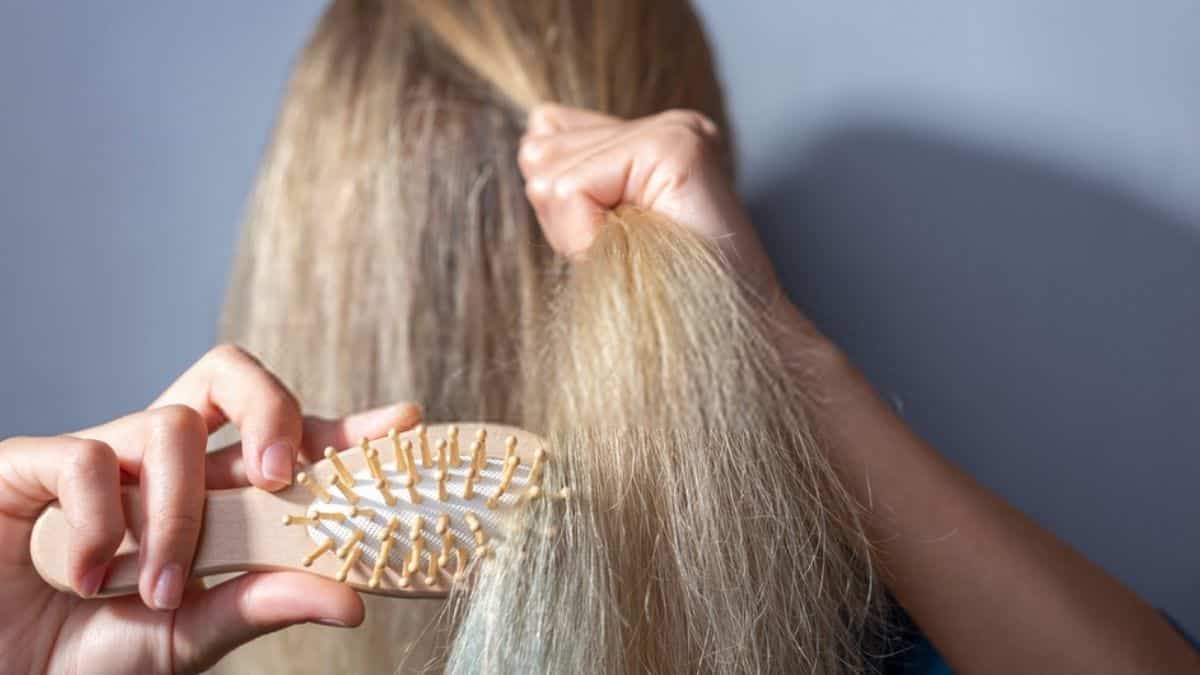DIY Deep Conditioner for Low Porosity Hair+ Achieving Healthy Hair

Maintaining vibrant and healthy hair goes beyond weather-induced dryness.
I will walk through DIY deep conditioning for low porosity hair techniques and homemade hair mask recipes to revitalize your hair in this post.
Causes of Low Porosity Hair
Heat styling equipment, dyes, and even the sun can deplete natural moisture and cause additional harm, especially to your ends.
A deep conditioner, on the other hand, will save your strands by adding moisture, shine, and softness to every hair form.
Trying a new DIY deep conditioner for low porosity hair may appear to be a lot of work, but believe me when I say that your hair will feel amazing once you’ve done it right!
Advantage of Protein Mask Deep Conditioning

Creating a Protecting Shield
A protein hair treatment works by adding hydrolyzed proteins to the hair cuticle and hardening the cuticle layer to fix hair strands.
Protein treatment can fill in any gaps in the hair cuticle and create a shield around the hair shaft to prevent further damage.
Restoring of Natural Oils
Standard conditioners relax hair, reduce frizz, and smooth the cuticles.
Deep conditioning, on the other hand, goes a step further by assisting in the restoration of the strands’ natural oils.
Prevent Hair Damage
It also improves texture and elasticity while preventing split ends and breakage.
If you use a deep conditioner on a regular basis, your hair will get shinier, smoother, and deeper.
Deep conditioning can be done on any hair type, however, damaged, brittle, or color-treated hair would benefit the most.
Homemade a hair mask for low porosity hair?
Step 1: Determine your requirements. Is your hair extremely brittle? Is there a shortage of definitions?
If you want to hydrate your hair, look for items that include ingredients like coconut oil, amino acids, and silicones.
Find goods that are high in protein if you want to revive your strands. Alternate between hydrating and protein-rich deep conditioners if you like a little bit of both.
Step 2: Consider your hair type when selecting a product. Choose a light solution that won’t weigh down your hair if you have fine hair.
Look for a frizz-fighting product if you have thicker hair. Make certain the ingredients address the issues you’ve found.
Step 3: Once you’ve found the right deep conditioner, determine if you want to use it pre-poo (before shampooing) or clean your hair first.
Are you unsure?
Washing the hair first opens up the cuticles for easier absorption, which helps jump-start the detangling process and works the treatment into dry hair.
Step 4: Once you’ve decided which method to use, work the deep conditioner into your hair from roots to tips.
It’s important to concentrate on the ends, which are usually the driest.
A wide-tooth comb will help you uniformly spread the product across your hair and get rid of those annoying knots faster.
Step 5: Wait for 20 to 40 minutes after covering your hair with a shower cap or plastic wrap (time will vary depending on the thickness and length of your hair).
Heat your hair with a blow dryer on the lowest heat setting to loosen up the cuticles and maximize the benefits of the deep conditioner.
five homemade deep-conditioning hair mask recipes
Here are five homemade deep-conditioning hair mask recipes, because what could be more fun than pretending to be a scientist in your own kitchen?
Olive Oil and Honey
We already love using olive oil to rehydrate dry, brittle hair, and adding honey adds an extra layer of hydration.
Whisk together 14 cups honey and 14 cups olive oil until smooth. (If you want a less sticky substance, add more olive oil.)
Apply the mixture to damp hair after washing it with shampoo.
Cover with a plastic bag or a shower cap. Allow 20 to 40 minutes for the process to complete.
Rinse and finish your hair washing routine when the timer goes off.
Depending on your level of dryness, use this deep conditioner once or twice a week.
Coconut Oil and Egg Yolk
Look no further than this combination if your hair is in need of some strength training.
This mask can be used on dry, damaged, or curly hair to minimize protein loss, increase moisture, and avoid breakage.
Whisk together 1 egg yolk and 2 tablespoons of melted coconut oil until smooth.
(Depending on the length and thickness of your hair, use more of each ingredient.)
Apply to damp hair after shampooing and keep on for 15 to 20 minutes before rinsing with cool water.
Mayonnaise and avocado
This mixture contains antioxidant vitamins C and E, which help to keep hair shiny, smooth, and hydrated.
Stir together half an avocado and 14 cups mayonnaise until smooth.
You may also block the mayo scent with a few drops of your favorite essential oil.
Cover your hair with a shower cap after massaging the treatment into it.
Allow for a 20-minute cooling period before rinsing and beginning your wash routine.
For smoother hair, use this deep conditioner once a week.
Honey and Banana
The potassium, vitamin C, and biotin found in bananas, when combined with honey (which promotes hair growth, volume, and shine), make for an effective deep conditioner.
This mixture will help make hair smooth, solid, and thick, if you want to prevent dandruff, moisturize your scalp, boost shine, or all of the above.
In a cup, mash a ripe banana and whisk in 1 tablespoon honey.
Depending on the length, dryness, and thickness of your hair, you can need to add more honey.
Cover wet or dry hair with the mixture for 20 to 30 minutes. Rinse and shampoo your hair as normal.
Honey, Greek yoghurt, and apple cider vinegar
Nobody likes frizz, and this combination keeps flyaways at bay.
The Greek yogurt offers the protein your hair craves while the apple cider vinegar stimulates hair development, detangles hair, and makes it shiny.
12 cup plain Greek yogurt, 1 tablespoon apple cider vinegar, and 1 tablespoon honey are combined in a bowl.
If you want to make the mask smell good, add essential oil.
Apply to damp hair, wait for 15 to 20 minutes, then rinse.
Hair Masks Versus Deep Conditioners
For certain people, deciding between a hair mask and a deep conditioner is often a challenge.
They can’t tell the difference between a hair mask and a conditioner, so they mix them up.
They keep claiming to have hair conditioner masks, but masks are for restoring facilities, while conditioners are for maintenance.
As a result, hair masks and conditioners cannot be compared.
There are some advantages to using a hair conditioner, just as there are advantages to using a hair mask.

To achieve better and faster results, some people use a hair mask with a conditioner.
It won’t work any better, though, because they each have their own strategies and goals. Let’s see which one is the most suitable.
Deep conditioning low porosity curly hair

Curly-haired women have a variety of strands, textures, and curls.
The first step in selecting the best deep conditioner is to determine if your hair has a low, medium, or high porosity.
Like me, you may have both in various sections of your hair in some situations.
Except for the crown of my scalp, which has a high porosity, I have low porosity hair.
Porosity refers to the hair’s capacity to retain moisture.
Since the cuticle is closed and difficult to open, low porosity hair has a hard time holding moisture.
Since the cuticle is open, high porosity hair absorbs moisture better. Normal porosity hair is a mix of the two.
When you rinse the cuticle with warm water, it opens up, and when you rinse it with cold water, it closes up.
I’ve read a lot of blogs about deep conditioners, but I realized I don’t have a DIY deep conditioner for low porosity hair.
Since low porosity has a hard time opening its cuticle, it needs assistance to maintain moisture.
I looked into a few ingredients that could help with low porosity curls.
Let’s get this party started.

Honey and glycerin are excellent for hair with low porosity.
They’re both emollients, so they’ll keep the curls hydrated. Any lightweight sulfate conditioner would suffice.
Hask’s Coconut Milk and Honey are my favorite.
Lightweight oils, such as Olive, Coconut, Alma, Jojoba, and Almond oil, are ideal for low porosity because they are more easily absorbed.
You’ve probably noticed that I talk a lot about lightweight items.
The explanation for this is that low porosity makes it easier for lightweight products, especially water-based products, to absorb.
Since heavier items weighed down my curls, I discovered this through trial and error.
Method: In a microwave-safe cup, combine honey and all of your essential oils.
It’s easier for the raw and coconut oil to break down in the microwave.
After that, mix in your glycerin and conditioner. Toss the ingredients together thoroughly.
I used warm water to shampoo my hair with Hask Coconut Milk and Honey because it is easier for my hair cuticles to open up.
When my hair was damp, I wrapped it in a microfiber towel and sectioned it off before applying my deep conditioner.
To absorb moisture, low porosity hair needs a lot of time and warm air.
I like to leave my deep conditioner on all day before I shower in the evening, but I make an effort to leave it on for at least 30 minutes.
Rinse hair with warm water, then apply your regular conditioner, rinse again, and apply your leave-in conditioner with oil or styling cream.
After rinsing the deep conditioner out, my hair was super smooth, incredibly moisturized, and surprisingly frizz-free, particularly around my crown.
Unlike every other deep conditioner, my hair liked this DIY deep conditioner.
Low porosity cannot handle a lot of products; limit yourself to no more than two.
More than two products, particularly very creamy products, can weigh down your curls and trigger product buildup, which is common in low porosity hair.
It will be easier to find the right items for your hair and how to describe your curls now that you know the porosity of your hair. I enjoy learning new ways to make things.
Final Thoughts
A homemade mixture can be kept in the fridge for two or three days. If you leave it any longer, bacteria will begin to spread.
And if you already have a favorite store-bought deep conditioner, why not make it even better by adding any of the ingredients mentioned above?
Whatever you like, deep conditioning your hair will result in far healthier tresses.
